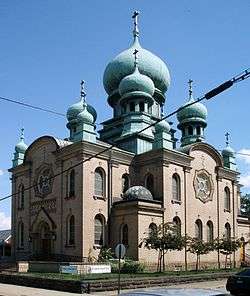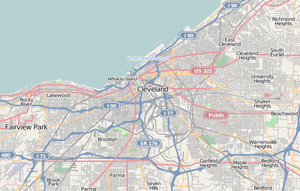St. Theodosius Russian Orthodox Cathedral
| St. Theodosius Russian Orthodox Cathedral | |
|---|---|
 St. Theodosius | |
| Location | 733 Starkweather Ave., Cleveland, Ohio |
| Country | United States |
| Denomination | Orthodox Church in America |
| Website | http://www.sttheodosius.org |
| History | |
| Founded | September 28, 1896 |
| Architecture | |
| Architect(s) | Frederick C. Baird |
| Specifications | |
| Number of domes | 13 |
| Administration | |
| Deanery | Cleveland Deanery |
| Diocese | Diocese of the Midwest |
| Clergy | |
| Bishop(s) | The Right Reverend Paul |
| Dean | V. Rev. John E Zdinak |
|
St. Theodosius Russian Orthodox Cathedral | |
   | |
| Coordinates | 41°28′38″N 81°40′54″W / 41.47722°N 81.68167°WCoordinates: 41°28′38″N 81°40′54″W / 41.47722°N 81.68167°W |
| Built | 1911 |
| Architect | Baird,Frederick C. |
| Architectural style | Other |
| NRHP Reference # | 74001453[1] |
| Added to NRHP | January 18, 1974 |
St. Theodosius Russian Orthodox Cathedral is a Russian Orthodox cathedral located on Starkweather Avenue in the Tremont neighborhood, on the near west side of Cleveland, Ohio. It is considered one of the finest examples of Russian church architecture in the U.S.[2] and is listed on the National Register of Historic Places.[1][3]
The parish is the first Orthodox parish in Cleveland[4] and is currently under the jurisdiction of the Diocese of the Midwest of the Orthodox Church in America.[5]
St. Theodosius is perhaps best known for its appearance in the 1978 film, The Deer Hunter with Robert De Niro, Christopher Walken, and Meryl Streep.
Dedication
Saint Theodosius of Chernigov, the patron saint to which the cathedral is dedicated, was born in the early 1630s in Podolia.[6]
The name given to him in baptism is unknown.
He was educated at the Brotherhood Monastery in Kiev.[6]
He became a monk at the Kiev Caves Monastery and named Theodosius, in honor of Theodosius of Kiev.[6]
He was later ordained as a celibate priest at the Saint Nicholas Krupytskyi Monastery near Baturyn.[6]
In 1662, he was appointed hegumen of the Korsun Monastery in Kaniv.[6]
In 1664, he was appointed hegumen of the Vydubychi Monastery in Kiev.[6]
In 1680, he established a small skete on the island of Mikhailovschino or Mikhailovschina.
In 1688, he was appointed archimandrite of the Yeletskyi Dormition Monastery in Chernigov.[6]
On September 13, 1692, he was consecrated archbishop in the Dormition Cathedral in the Moscow Kremlin.[6]
In 1694, a skete was founded near Liubech.[6]
Saint Theodosius died on February 5, 1696 and was buried in the Cathedral of Saints Boris and Gleb in Chernigov.[6]
History
The parish was organized, in 1896, when the tide of immigration of Eastern Europeans to the United States was at an all-time high,[7] by Rusyn immigrants,[2][4] living in Tremont, who had immigrated from Galicia and Carpathian Ruthenia.[4]
The congregation that founded the parish was formed from a group of disgruntled former worshippers at a Byzantine Rite Eastern Catholic Church, conflicts led 23 men to form the St. Nicholas Society on September 28, 1896.[2]
That society led to the formation of an organized parish[2] As the first Orthodox parish in Cleveland, it served the spiritual needs of ethnic groups of Orthodox Christians which had not yet established their own ethnic churches.[7] The Baptism of the first known Romanian child born in the United States, Aurelia Zeicu, has been recorded in the parish.[8]
The first church structure was a light-frame construction building, at Literary Rd. and W. 6th St., built in 1896.[2][4]
The Russian Missionary Fund established by Czar Nicholas II provided financial assistance.[7]
The second church structure was the former Sisters of St. Joseph Convent.[lower-alpha 1] In 1902, the parish bought the former Sisters of St. Joseph Convent[2][7] and sold 80 individual lots from the convent land to parishioners for $125 apiece to raise funds.[9]
In 1909 the parish purchased land in Brooklyn for a cemetery.[2] The property had a wooden barn on it and one of the monks from St. Theodosius used to come out there on Saturdays to teach the Russian language to the children who lived too far away to attend Russian classes at the church.[7]
The current cathedral is the parish's third church structure.[2] It was completed at an estimated cost of $70,000.[4]
The cathedral was consecrated by Bishop Alexander (Nemolovsky) on Sunday, July 20, 1913.
Starting in 1917, world events affected the Russian Orthodox Church, the Russian Revolution abolished the Most Holy Synod and restored the Patriarchate. The Most Holy Synod administered all church property and controlled the expenditure of churches and monasteries.[10] A new synod elected Tikhon of Moscow patriarch. Russian Civil War violence devastated the Russian Empire. Church publications were prohibited.
February 25–28, 1919, hosted the Second All-American Sobor which set a precedent, by electing Alexander (Nemolovsky) to the rank of Archbishop of the Aleutians and North America, for future elections of the Church's primates by later councils. This made him the first primate to be chosen locally in North America.[11]
The Russian Orthodox Church was weakened again and further dissociated in 1922, when the Living Church, a Soviet government supported movement, dismissed the Patriarch and restored a Synod to power.[12]
November 20–23, 1934, hosted the Fifth All-American Sobor which elected primate Theophilus (Pashkovsky).[13]
November 26–29, 1946, hosted the Seventh All-American Sobor which broke ties between the Orthodox Church in America and Russian Orthodox Church Outside Russia.[14]
The cathedral was rededicated on October 3, 1954.[2]
Since the late 1950s, the clergy celebrated the liturgy in both Church Slavonic and English languages.[2] Today there is only one Sunday liturgy and it is in English and parts in Slavonic.
On January 18, 1974, the building was placed on the National Register of Historic Places[1] and was designated a Cleveland Landmark.[2][15]
In the summer of 1977, St. Theodosius served as the site for the wedding scene in the film The Deer Hunter.[2] According to the film credits, the parish's own Father Stephen Kopestonsky, was cast as the priest in the scene.[16] On June 16, 1961, it also appeared in an episode of the TV series Route 66 ("Incident On a Bridge").
Clergy
| Known members of the clergy of the cathedral | |
|---|---|
| Dates | priest |
| 1896 | John Nedzelnitsky (1866–1946) |
| 1897–1902 | Victor Stepanov (…–1920) |
| 1902–1908 | Jason R. Kappanadze (1874–1962) |
| 1908 | Vasily Vasilyev (…–1956) |
| 1909 | John Chepeleff (1880–1967) |
| 1910–1921 | Basil S. Lisenkovsky (…–1968) |
| 1915 | K. Karpenko |
| 1915 | Arkady Petrovsky |
| 1915 | Basil Rubinsky |
| 1921 | Alexander Kukulevsky (1873–1963) |
| 1922–1957 | Jason R. Kappanadze (1874–1962) |
| 1958 | Peter Bogusz (…–1959) |
| 1959–1963 | Igor Tkachuk (1918–1995) |
| 1964–1976 | Sergei Kuharsky |
| 1976–1987 | Stephen Kopestonsky |
| 1988 | Jason Cupp |
| 1988–1999 | Jason R. Kappanadze |
| since 1999 | John E. Zdinak |
Architecture
The cathedral was built in a recognizable Neo-Byzantine style; a type of Russian church architecture with one large, four medium, and eight small copper onion domes, symbolic of Christ and the twelve apostles.[7] The cathedral is considered one of the best representatives of Russian church architecture in the U.S.[2] with design features, by Cleveland architect Frederick C. Baird, based on photographs of the original Cathedral of Christ the Saviour in Moscow, Russia.[2][4]
The iconostasis, separating the sanctuary from the larger portion of the cathedral accessible to the faithful, contains the following icons imported from Russia:[2]
- above – Crucifix with the Blessed Virgin Mary and John the Baptist;
- top tier – the Twelve Apostles to either side of an icon depicting the Holy Trinity;
- middle tier of smaller icons – various saints to either side of an icon depicting the Last Supper over the Royal Doors;
- bottom tier (left to right) – Saint Nicholas, Archangel Michael, Mother of God, the Royal Doors, the Savior, Archangel Gabriel, Saint Theodosius of Chernigov.
In 1953 the church commissioned murals by noted Russian fresco painter Andrej Bicenko.[2] Included in a mural is the likeness of an early pastor, Jason Kappanadze.[17]
Notes
- ↑ This is named as "St. John's Convent" in several sources.
References
- 1 2 3 National Park Service (2008-04-15). "National Register Information System". National Register of Historic Places. National Park Service.
- 1 2 3 4 5 6 7 8 9 10 11 12 13 14 15 16 "St. Theodosius Russian Orthodox Cathedral". The Encyclopedia of Cleveland History. Case Western Reserve University. 22 July 1997. Retrieved 24 October 2012.
- ↑ Mitchell, Sandy (30 June 2007). "St. Theodosius Russian Orthodox Cathedral". About.com. Retrieved 24 July 2007.
- 1 2 3 4 5 6 Rotman, Michael. "St. Theodosius Cathedral". Cleveland Historical. Cleveland State University Department of History. Retrieved 24 October 2012.
- ↑ "St. Theodosius Cathedral". Orthodox Church in America. Retrieved 24 October 2012.
- 1 2 3 4 5 6 7 8 9 10 "Repose of St Theodosius of Chernigov". Orthodox Church in America. Retrieved 23 October 2012.
- 1 2 3 4 5 6 Lynette, Filips (January 2007). "St. Theodosius Cathedral – where Great Russians, Belarusians, Carpatho-Rusins and even some Ukrainians worshipped" (PDF). Old Brooklyn News. Old Brooklyn Community Development Corporation. p. 8. Retrieved 25 October 2012.
- ↑ Grama, Remus. "Parish History". St. Mary's Romanian Orthodox Cathedral. Retrieved 23 October 2012.
- ↑ Houck, George (1903). A history of Catholicity in northern Ohio and the diocese of Cleveland from 1749 to December 31, 1900. Cleveland: Press of J.B. Savage. p. 729. Retrieved 25 October 2012.
In 1880 the Sisters bought a five-acre tract of land on Starkweather avenue, to which they added five acres a few years later. The frame house on the land first purchased was remodeled to serve as a temporary Convent and private school; the Sisters moved thither from Fulton street in July, 1880. Ten years later they built a commodious two-story stone structure on the same site, for their Motherhouse and academy. ... In a few years the Convent property on Starkweather avenue proved unsuitable for the purposes of an academy, because of its location.
- ↑ Fortescue, Adrian (1913). "Holy Synod". The Catholic Encyclopedia. Robert Appleton Company. Retrieved 23 October 2012.
- ↑ Liberovsky, Alexis. "Synopsis of the 2nd All-American Sobor". Orthodox Church in America. Retrieved 23 October 2012.
- ↑ "RUSSIA: Fall of Tikon". Time magazine. 12 May 1923. Retrieved 25 October 2012.
- ↑ Liberovsky, Alexis. "Synopsis of the 5th All-American Sobor". Orthodox Church in America. Retrieved 23 October 2012.
- ↑ Liberovsky, Alexis. "Synopsis of the 7th All-American Sobor". Orthodox Church in America. Retrieved 23 October 2012.
- ↑ "St. Theodosius Russian Orthodox Cathedral & Hall". Cleveland City Planning Commission. Retrieved 24 October 2012.
- ↑ http://www.imdb.com/name/nm0465766/
- ↑ "Kappanadze, Jason R.". The Encyclopedia of Cleveland History. Case Western Reserve University. 10 July 1997. Retrieved 24 October 2012.
External links
| Wikimedia Commons has media related to St. Theodosius Russian Orthodox Cathedral. |

